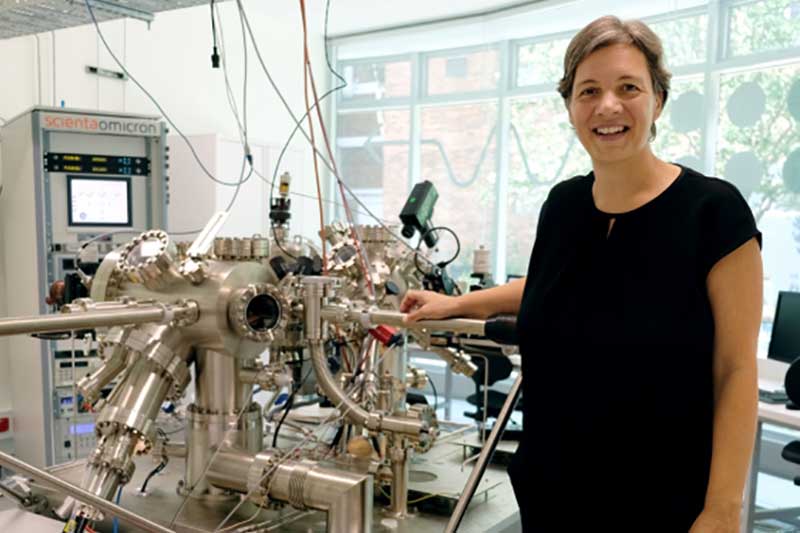
A team of scientists from the University of New South Wales
(UNSW) led by UNSW Scientia Professor Michelle Simmons, Director of the Centre
of Excellence for Quantum Computation and Communication Technology, or CQC2T has
demonstrated
for the first time that they can make two atom quantum bits or qubits,
generated from precisely positioned individual atoms in silicon, “talk” to each
other.
The team creates the atom qubits by precisely positioning
and encapsulating individual phosphorus atoms within a silicon chip.
Information is stored on the quantum spin of a single phosphorus electron.
This new advance, published in the journal, Nature Communications,
shows the first observation of controllable interactions between two of these
qubits. A scanning probe was used to directly measure the atom’s wave function,
telling its exact physical location in the chip.
This enables the scientists to place their high-quality
qubit where they want it in the chip, see what they have made, and then measure
how it behaves. They can add another qubit nearby and see how the two wave
functions interact and then begin generating replicas of the devices that have been
created.
For the study, the team placed two qubits – one made of two
phosphorus atoms and one made of a single phosphorus atom – 16 nanometres apart
in a silicon chip.
Using electrodes that were patterned onto the chip with
similar precision techniques, the researchers were able to control the
interactions between the two neighbouring qubits, so the quantum spins of their
electrons became correlated or entangled. Quantum computing utilises this kind
of quantum-mechanical phenomena to perform operations on data.
Study lead co-author, Dr Matthew Broome, formerly of UNSW
and now at the University of Copenhagen, said “These type of spin correlations
are the precursor to the entangled states that are necessary for a quantum
computer to function and carry out complex calculations.”
The prediction from theory was that the two qubits would
need to be placed 20 nanometres apart to see the correlation effect but it was
found to occur at only a 16 nanometres gap.
“In our quantum world, this is a very big difference. It is
also brilliant, as an experimentalist, to be challenging the theory,” Study
lead co-author, UNSW’s Sam Gorman said.
Prof Simmons’ team has also recently created quantum
circuitry with the lowest recorded electrical noise of any semiconductor device,
by optimising their nano-manufacturing process. Electrical noise from the circuitry
that controls the qubits is believed to be a critical factor in limiting their
performance.
Using silicon avoids the problem faced by most other devices
of having a mix of different materials, including dielectrics and surface
metals that can be the source of, and amplify, electrical noise.
The team has also created an electron spin qubit with the
longest lifetime ever reported in a nano-electric device – 30 seconds – up to
16 times longer than previously reported. Qubits have a fleetingly brief lifespan
which is one of the barriers in the development of complex quantum computers. A
longer lifetime, allows information to be stored longer in the quantum state. In
the same paper, they showed that these long lifetimes allowed them to read out
the electron spins of two qubits in sequence with an accuracy of 99.8 percent
for each, which is the level required for practical error correction in a
quantum processor.
In the same paper, they showed that these long lifetimes
allowed them to read out the electron spins of two qubits in sequence with an
accuracy of 99.8 percent for each, which is the level required for practical
error correction in a quantum processor.
Prof Simmons said, “The combined results from these three
research papers confirm the extremely promising prospects for building
multi-qubit systems using our atom qubits.”
According to the press release, UNSW scientists and
engineers at CQC2T are leading the world in
the race to build a quantum computer in silicon. They are developing parallel
patented approaches using single atom and quantum dot qubits. Prof Simmons
expressed hope that both approaches would work.
The UNSW team have chosen to work in silicon because it is
among the most stable and easily manufactured environments in which to host
qubits. Moreover, there is a vast body of knowledge about silicon because of
its long history of use in the conventional computer.
Last year, UNSW launched
Australia’s first hardware quantum computing company, Silicon Quantum Computing
Pty. Ltd. (SQC) to commercialise CQC2T’s world-leading research. Operating out of new laboratories at UNSW, SQC has set a target of producing a 10-qubit demonstration device in silicon by 2022, as the
forerunner to a silicon-based quantum computer.
The company is backed by a consortium of governments,
industry and universities. The Australian government has invested A$26 million
in the A$83 million venture through its National Innovation and Science Agenda,
with an additional A$25 million coming from UNSW, A$14 million from the
Commonwealth Bank of Australia, A$10 million from Telstra and A$8.7 million
from the NSW Government.
The press release from UNSW cites an estimate that
industries comprising approximately 40% of Australia’s current economy could be
significantly impacted by quantum computing.
















